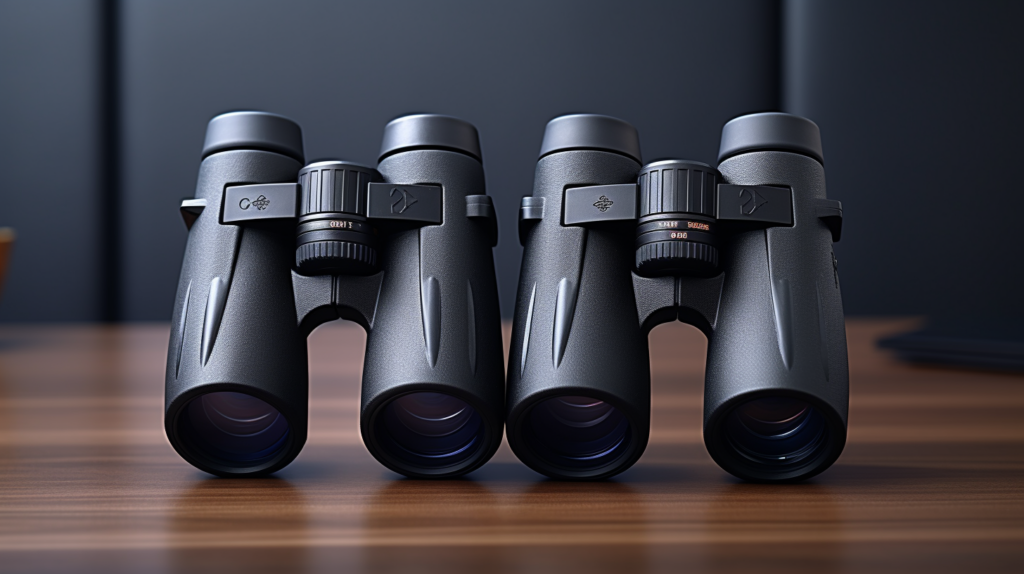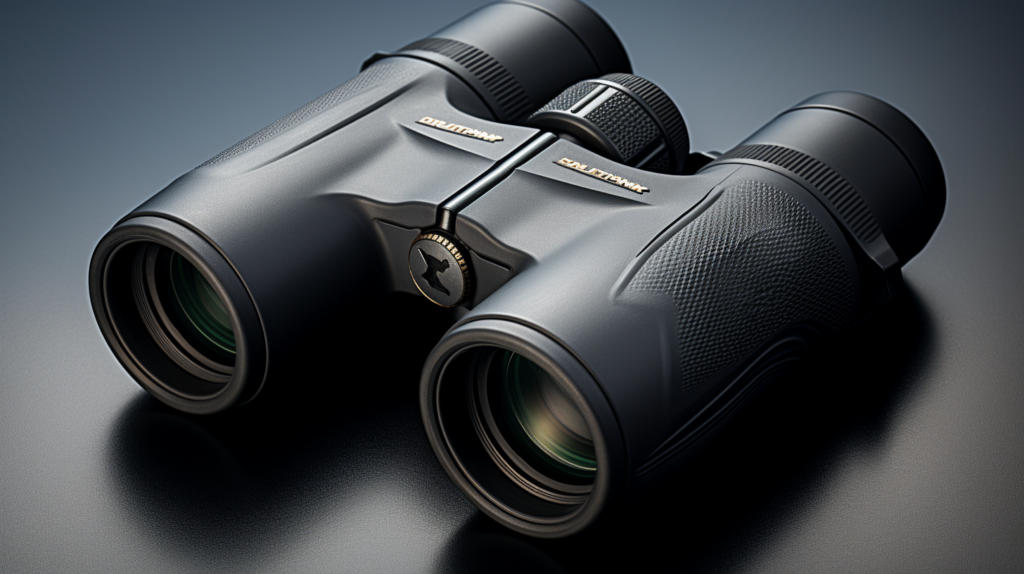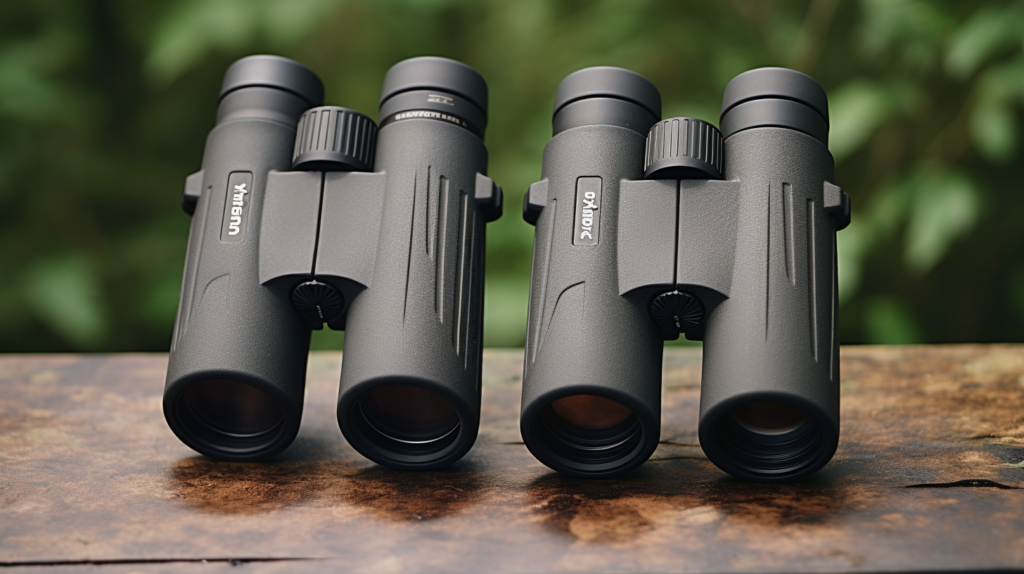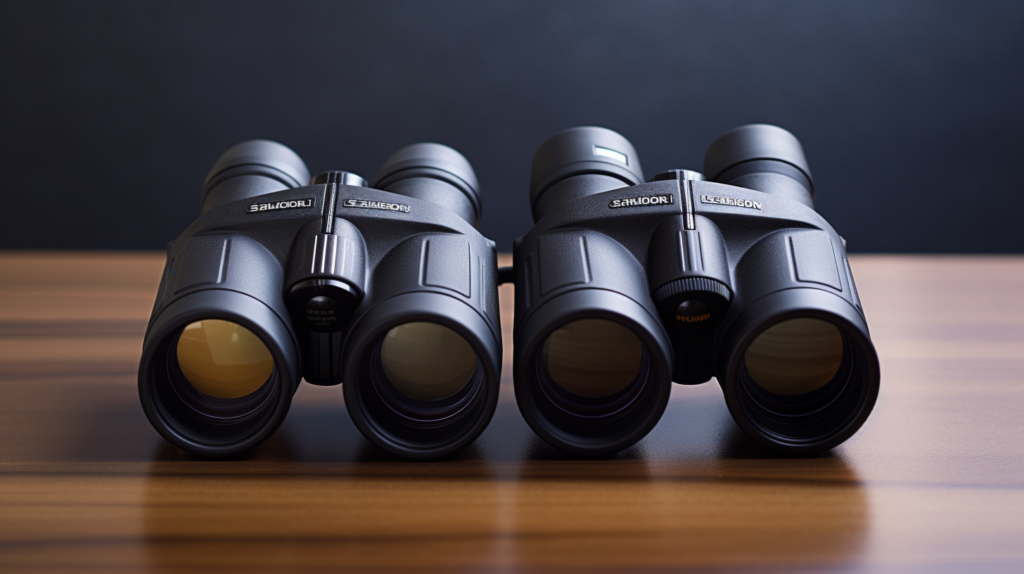Table of Contents
Table of Contents

If you’ve been on the fence about whether to choose 8×42 or 10×42 binoculars, you’re not alone. These numbers aren’t just random; they signal critical factors like magnification and field of view that could make all the difference in your viewing experience.
Our blog post will unravel these specifications, comparing both sets of binos side by side to help you better understand their strengths and weaknesses. Stick around as we decode the language of optics for your benefit!
Key Takeaways
- The numbers 8×42 and 10×42 on binoculars stand for magnification power and lens size.
- With 8×42 binoculars, you get a wider field of view and less image shake. They are better for bird watching and viewing large areas.
- With 10×42 binoculars, you can see far-off objects in more detail. But they might cause an image to shake if not stabilized properly. These types are good for hunters who need clear details from afar.
- Both models have the same light-gathering capabilities due to their similar lens size (42mm). This feature makes these binoculars good for low-light conditions like dusk or dawn.
Understanding Binocular Terminology

Before diving into the differences between 8×42 and 10×42 binoculars, it’s crucial to understand some basic binocular terminology. The two numbers in a binocular’s designation refer to magnification power and lens size respectively.
Magnification tells you how much closer an object appears compared to viewing with just your eyes, while lens size impacts the amount of light let in by the binoculars. Grasping these basics makes it easier to comprehend what sets various types of binoculars apart from each other.
Magnification
Magnification is a vital aspect to consider when choosing between 8×42 and 10×42 binoculars. This term refers to how much larger an object will appear compared to observing it with the naked eye.
An 8x magnification makes the view eight times closer, while a 10x magnification brings it ten times closer. However, each comes with its nuances. With higher magnification like in the case of 10x binoculars, you get more detail at longer distances but may experience image instability due to hand tremors or movements.
Lower magnifications such as that found in the 8x binoculars tend to result in lesser image shake and offer wider field views which are great for scanning vast landscapes or tracking fast-moving targets.
Lens Size
The lens size, also known as the objective lens diameter, is a key feature to consider when comparing 8×42 and 10×42 binoculars. Both types share the same lens size – a robust 42mm.
This similarity provides both models with equivalent light-gathering capabilities, crucial for crisp image formation under varied lighting conditions.
Larger lenses typically yield brighter images by admitting more light into the binoculars. They come in handy during low-light situations such as dawn or dusk observations or even birding in dense forests.
However, they also contribute to increased bulk and weight of the binoculars which might influence your choice depending on your intended use and portability needs.
Comparing 8×42 and 10×42 Binoculars

When you compare 8×42 and 10×42 binoculars, it’s essential to consider both the physical differences like size and weight, as well as optical aspects such as magnification power and light-gathering capabilities.
These factors directly impact the usage and performance of these two types of binoculars.
Physical Differences
The physical attributes of 8×42 and 10×42 binoculars set them apart. Generally, the 10×42 models weigh slightly more due to their higher magnification capabilities. This could be an important consideration for outdoor enthusiasts who need to carry their gear around all day.
Furthermore, the increased thickness in the lenses found in high-magnification binoculars enhances durability but may somewhat reduce light transmission. Despite these differences, both models are built to withstand harsh conditions, so opting for one over the other depends on individual usage needs and preferences.
Optical Differences
Optical differences between 8×42 and 10×42 binoculars play a significant role in their performance under various conditions. The higher magnification of the 10×42 binoculars offers more image detail, particularly at longer distances.
However, this advantage comes with an increased risk of image shake when you’re holding the binoculars by hand. Additionally, thicker lenses on the higher magnification model cause a slight reduction in light transmittance.
On the other hand, lower magnification in 8×42 binoculars provides a wider field of view which is beneficial for fast-moving targets or scanning large areas. Moreover, they possess a larger exit pupil due to their ocular lenses’ size, providing brighter images during low-light situations such as dawn or dusk wildlife observation.
Fundamentally choosing between these two models would boil down to one’s specific needs and considerations – be it high power viewing at long distances versus optimal performance in varied lighting conditions.
Pros and Cons of 8×42 Binoculars

The 8×42 binoculars offer a wider field of view, providing viewers with a more expansive look at their surroundings. The image stability in these binoculars is usually better due to the lower magnification which helps reduce handshake.
However, for twilight conditions and light-gathering capabilities, they might not perform as well as their counterpart because of the smaller exit pupil size. Despite that shortcoming, they are often favored for bird watching and other activities that require extended periods of viewing due to their less strain on the eyes and lightweight nature.
Field of View
The field of view is a crucial aspect when considering binoculars. In essence, it refers to the width of the area you can see through your lenses at a glance. Opting for 8×42 binoculars delivers a wider field of view compared to their 10×42 counterparts.
This wider perspective provides ample coverage and allows users to observe more of their surroundings effortlessly, which proves particularly beneficial in activities like bird watching or scanning vast landscapes swiftly.
Your choice between these two types often depends on what you primarily plan on using them for and the terrain you’ll be exploring.
Image Stability
With 8×42 binoculars, you’ll notice a steadier image compared to higher magnification models. This is because the lower power of 8x reduces shakes and vibrations caused by hand tremors during use.
On the other hand, 10×42 binoculars will show more details but can result in increased image shake if you’re holding them by hand for a prolonged time. Image stabilization becomes increasingly critical when observing fast-moving targets or trying to identify detailed features of birds or wildlife from afar.
To aid in maintaining stability while using high-powered optics like 10×42 binoculars, many bird watchers and hunters choose to use tripods or stationary positions for optimal viewing experiences.
Twilight Conditions & the Exit Pupil
The size of the exit pupil in binoculars becomes crucial during twilight conditions. Larger exit pupils allow more light to reach your eyes, enhancing image brightness when lighting is scarce.
That’s why 8×42 binoculars offer superior performance under low-light conditions with a generous exit pupil of 5.25mm. On the other hand, 10×42 binoculars present greater detail but sacrifice some low-light performance due to their smaller 4.2mm exit pupil, resulting in slightly darker images as daylight fades away.
Whether you’re birding at dawn or hunting at dusk, understanding how twilight factor and exit pupillary distance impact image quality can significantly enhance your viewing experience.
Pros and Cons of 10×42 Binoculars

10×42 binoculars offer viewers a higher magnification experience, allowing one to see objects or features further away in more detail. Despite this advantage, they tend to have some shortcomings like a lesser field of view and image stability due to their high power.
While 10×42 binoculars can capture more light than smaller models, making them great for low-light conditions, the higher magnification might cause image shake unless stabilized on a tripod or solid surface.
It’s important also to note that individuals with glasses might find less eye relief when using 10×42 binoculars compared to other models with lower magnifications.
Higher Magnification
10×42 binoculars offer higher magnification, giving users the ability to view objects in greater detail from a longer distance. However, this advantage comes with its own set of challenges.
The more you zoom in on an object, the harder it becomes to keep the image steady, especially when hand-holding your binoculars. This issue can be particularly problematic when tracking fast-moving targets like birds or sports players.
Also worth noting is that thicker lenses are often required for higher magnification which could potentially reduce light transmission; however, with high-quality 10×42 binoculars, this difference becomes negligible due to their superior glass and coating quality.
Light Gathering Capabilities
10×42 binoculars have impressive light-gathering capabilities that contribute to delivering bright and clear images. Their larger lens size allows more light to enter, providing enhanced visibility even in low-light conditions like dusk or dawn.
This feature is crucial for activities such as bird watching or hunting, where the ability to see clearly during varying lighting conditions can significantly impact the overall experience.
However, it’s worth noting that while 10×42 binoculars gather ample light, they may not always offer the brightest image especially compared to their 8×42 counterparts. The exit pupil is a measure of how much light reaches your eye when using the binoculars.
With a smaller exit pupil size of 4.2mm versus the 5.25mm found in an 8×42 pair, there is less room for light transmission resulting in potentially dimmer visuals under certain circumstances like dense woodlands or cloudy skies.
Therefore, choosing between these two types often depends on balancing magnification needs with anticipated lighting situations.
Eye Relief
Eye relief is a crucial aspect to consider in 10×42 binoculars, especially for those who wear glasses. This term refers to the distance from the eyepiece lens to your eye where you can still see the full field of view.
More extended eye relief means more comfort during prolonged periods of observation, particularly essential for bird watchers or hunters. Be aware that insufficient eye relief may cause dark circles in your vision known as vignetting.
Therefore, a generous amount of eye relief ensures an optimal viewing experience with complete visual fields and enhanced comfort using 10×42 binoculars.
Specific Uses for 8×42 and 10×42 Binoculars
While 8×42 binoculars excel in activities like birding and general use due to their wider field of view, the 10×42 versions offer better detail resolution making them ideal for hunting and observing distant events.
Explore more on how these subtle differences influence usability under varying circumstances!
Hunting
Hunters often opt for 10×42 binoculars in open country hunting or spot and stalk hunting for their greater reach and detail at long distances. However, the wide field of view offered by 8×42 binoculars makes them an excellent choice for hunting scenarios like timber hunting or bow hunting that involves targeting fast-moving subjects at shorter to mid ranges.
The larger exit pupil in the 8×42 model provides a brighter image in low light conditions, vital when dawn or dusk are prime times for certain games to be active. Choosing between these two models largely hinges on your specific hunting terrain and style—whether it’s scanning far-off horizons from a stationary position with high-powered optics or needing quick clarity on targets moving through dense woodlands with lower-powered but broader viewing scopes.
Birding
Birding often involves observing species from various distances and in a range of environments. For this activity, selecting the appropriate binoculars can significantly enhance your bird-watching experience.
The 8×42 binoculars are highly versatile, allowing for wide field views which is ideal when tracking fast-moving birds or scanning large areas, beneficial for different settings. Alternatively, the 10×42 binoculars have higher magnification power that reveals more details at longer ranges which is excellent during normal to good light conditions.
Both sets offer unique advantages to cater to your birding needs across diverse terrains such as woodlands, wetlands, or open spaces.
Event Observation
From live concerts to sports games, binoculars take center stage as an essential tool. The 8×42 binoculars give you a wider field of view which is especially useful when trying to follow fast-paced action.
Imagine using them at a soccer match where players move quickly across the field – the wide view would allow you to keep track of multiple players at once. On the other hand, the 10×42 binoculars offer higher magnification power perfect for events occurring farther away – say in music festivals or NASCAR races where musicians and cars often appear as specks from spectator seats.
You can capture crisp clear details with these high magnifying binoculars even from rows back. Both 8×42 and 10×42 configurations perform equally well under different lighting conditions making them versatile choices for event observation.
Conclusion
Differentiating between 8×42 and 10×42 binoculars centers on personal needs and purpose. When a wider view with stable imaging is required, the 8×42 configuration excels. In contrast, the more detailed imagery at long distances delivered by the 10×42 comes into play for focused observations.
The ultimate goal, be it bird watching or event observation, will guide your decision in choosing the right type of binoculars.
FAQs
1. What is the difference between 8×42 and 10×42 binoculars?
The main differences between 8×42 and 10×42 binoculars are their magnification power (with one offering eight times magnification, and the other ten times), optical performance, low light performance, physical characteristics, size and weight
2. Are there significant price variations between 8×42 vs 10×42 binoculars?
Prices can differ based on various factors such as brand or build quality; however, higher magnification like in a 10×42 doesn’t always result in a more expensive pair of binoculars than an equivalent quality but lower-powered optic.
3. Which type of binoculars should I use for birding or safari?
For slow-moving targets like perched birds or safari viewing where further distance reach is needed, the better glassing capabilities of a pair of high-quality 10×42 binoculars might be preferable.
4. Is there any advantage to using an 8X instead when mountain hunting?
Yes! If you have hand tremor issues or need to keep your backpack weight down while mountain hunting in dense areas with lots of short- to mid-distances viewings, then compact yet cheaper well-built similar quality level eyepiece lenses from brands like Canon or Vortex that deliver steady image even under dim light conditions could make ease-of-use considerations tilt favorably towards opting for lighter-weighted structures within specific lineups offered by certain brands featuring only either all low- powered optics models themselves including those numbered at eight times magnified ones too!
5. In terms of optical quality which performs best among these two types?
Optical performance varies depending upon diverse aspects alongside just solely focusing on the core part about what numbers exactly appear imprinted across each unit’s outer surfaces alone rather though still they significantly affect overall results nevertheless inevitably thus meaning that those chosen previously before acquiring such tools should reasonably expect to encounter variations ranging over vast spectrums concerning issues linked directly onto whether customers get exactly the desirable level of image clarity they were hoping for or not.
6. Can I use both types if I wear glasses?
Yes, most binocular designs these days including both 8×42 and 10×42 allow comfortable usage even with eyewear on but remember to adjust eye relief settings appropriately first before using them!
7. What are the physical differences between 8×42 and 10×42 binoculars?
Physically, 8×42 and 10×42 binoculars have similar dimensions and weight. However, 10×42 binoculars may be slightly heavier due to the higher magnification. Both models typically have similar optics and features.
8. Which one is better, 8×42 or 10×42?
Choosing between 8×42 and 10×42 binoculars depends on your specific needs and preferences. The 8×42 binoculars generally have a wider field of view, providing a better overview of the surroundings. On the other hand, 10×42 binoculars offer greater magnification for more detailed observations, especially when the subject is farther away. Consider your primary use for the binoculars to determine which one suits you best.
9. Are there any advantages of 8×42 binoculars?
Yes, there are advantages to using 8×42 binoculars. They typically have a larger exit diameter of the objective lens, which allows more light to enter the binoculars, resulting in brighter images. The wider field of view is beneficial for activities such as birding or sports where a broader perspective is desired.

